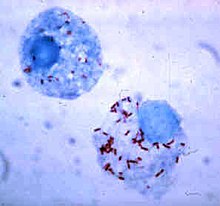Intracellular bacteria

Intracellular bacteria are bacteria that have the capability to enter and survive within the cells of the host organism.[1] Many of them are capable of growth extracellularly, but some of them can grow and reproduce only intracellularly (obligate intracellular parasites). Besides bacteria, there are other kinds of intracellular microorganisms.
Examples of non-obligate intracellular bacteria include members of the genera Brucella, Legionella, Listeria, and Mycobacterium. Examples of obligate intracellular bacteria include members of the order Rickettsiales and members of the genus Mycoplasma.[1]
See also
- Endosymbiont
References
- ^ a b Levinson, Warren (2018). Review of medical microbiology and immunology (15th ed.). New York. ISBN 978-1-259-64450-4. OCLC 1225889723.
{{cite book}}: CS1 maint: location missing publisher (link)
- v
- t
- e
Microbiology: Bacteria
microbiology
- Infection
- Exotoxin
- Lysogenic cycle
- Pathogenic bacteria
- Resistance
and ecology
| Oxygen preference | |
|---|---|
| Other |
| Cell envelope | |
|---|---|
| Outside envelope | |
| Composite |
and evolution
- Bacteria (classifications)
- Bacterial phyla
- Former groupings: Schizomycetes
- Monera
- Prokaryota
 Category
Category Commons
Commons
 | This bacteria-related article is a stub. You can help Wikipedia by expanding it. |
- v
- t
- e













